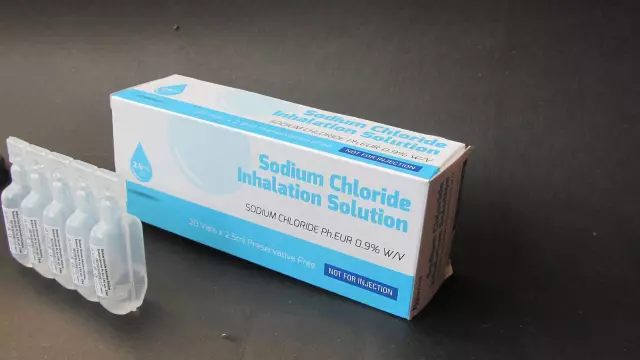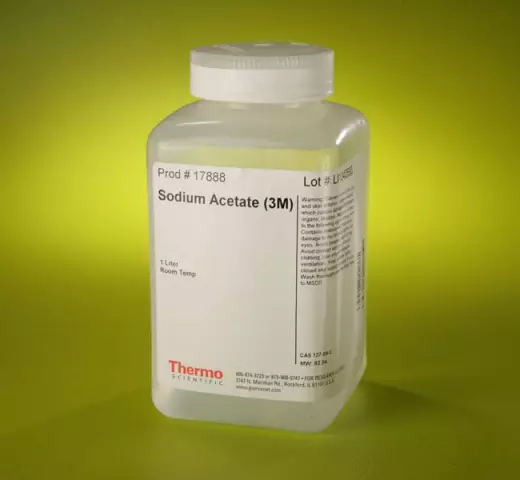- Author Rachel Wainwright [email protected].
- Public 2023-12-15 07:39.
- Last modified 2025-11-02 20:14.
Sodium adenosine triphosphate
Sodium adenosine triphosphate: instructions for use and reviews
- 1. Release form and composition
- 2. Pharmacological properties
- 3. Indications for use
- 4. Contraindications
- 5. Method of application and dosage
- 6. Side effects
- 7. Overdose
- 8. Special instructions
- 9. Application during pregnancy and lactation
- 10. Use in childhood
- 11. Drug interactions
- 12. Analogs
- 13. Terms and conditions of storage
- 14. Terms of dispensing from pharmacies
- 15. Reviews
- 16. Price in pharmacies
Latin name: Adenosintriphosphate sodium
ATX code: C01EB
Active ingredient: triphosadenine (Triphosadenine)
Producer: Ellara LLC (Russia), FSUE NPO Microgen (Russia)
Description and photo update: 09.10.2019
Prices in pharmacies: from 229 rubles.
Buy

Sodium adenosine triphosphate is a drug that improves tissue energy supply and metabolism.
Release form and composition
The drug is available in the form of a solution for intravenous administration, which is a slightly yellowish or colorless transparent liquid [1 ml in ampoules: 5 ampoules in blisters made of polyvinyl chloride (PVC) or polyethylene terephthalate (PET) film, in a cardboard box 1 or 2 contour cell packaging, ampoule scarifier and instructions for the drug; 5 or 10 ampoules in a corrugated cardboard insert, in a cardboard box 1 corrugated insert, an ampoule scarifier and instructions for the preparation; each pack also contains instructions for the use of Sodium adenosine triphosphate; for hospitals - 4, 5 or 10 blister packs in cardboard boxes together with an equal number of instructions or 50 or 100 blister packs in corrugated cardboard boxes together with an equal number of instructions;when using ampoules with a break point or ring, do not insert the ampoule knife].
Composition of 1 ml solution for intravenous administration:
- active substance: triphosadenine (adenosine triphosphate of disodium salt) - 10 mg;
- auxiliary components: sodium bicarbonate, propylene glycol, sodium carbonate anhydrous, disodium edetate dihydrate, water for injection.
Pharmacological properties
Pharmacodynamics
Sodium adenosine triphosphate is a metabolic agent with antiarrhythmic and hypotensive effects, as well as dilating cerebral and coronary arteries.
Triphosadenin is a natural high-energy compound. It is formed in the body during the glycolytic breakdown of carbohydrates and as a result of oxidative reactions. This compound is found in many tissues and organs, but the largest amounts of adenosine triphosphate disodium salt are found in skeletal muscles.
The drug improves metabolism and tissue energy supply. Triphosadenine is broken down into adenosine diphosphate and inorganic phosphate, while a large amount of energy is released, which is used for the synthesis of urea, protein, muscle contraction, the formation of intermediate metabolic products, etc. The breakdown products of triphosadenine are included in the resynthesis of ATP (adenosine triphosphate).
Under the influence of Sodium adenosine triphosphate, smooth muscles relax, blood pressure decreases, the contractility of the heart muscle increases, the transmission of excitation from the vagus nerve to the heart and the conduction of impulses in the autonomic ganglia improves.
Pharmacokinetics
With parenteral administration of Sodium adenosine triphosphate, it is impossible to track the kinetics of the active substance due to the wide variety of reactions that take place with the participation of its own ATP. It is known that at the site of sodium administration, adenosine triphosphate rapidly decomposes into adenosine and phosphate residues, which are later used to form new ATP molecules.
Indications for use
Sodium adenosine triphosphate is used to relieve paroxysms of supraventricular tachycardia (except for atrial flutter and / or fibrillation).
Contraindications
Absolute:
- severe arterial hypotension;
- SSSU (sick sinus syndrome);
- long QT syndrome;
- acute myocardial infarction;
- decompensated chronic heart failure or acute heart failure;
- AV block II - III degree (except for patients with an artificial pacemaker);
- clinically significant or severe (heart rate less than 50 beats per minute) bradycardia between attacks;
- COPD (chronic obstructive pulmonary disease);
- bronchial asthma;
- children and adolescents up to 18 years old;
- joint reception with dipyridamole;
- breast-feeding;
- hypersensitivity to the components of the drug.
Relative (sodium adenosine triphosphate solution is used with caution):
- AV block I degree;
- flutter and atrial fibrillation;
- Ischemic heart disease (coronary heart disease);
- stenosis of the heart valves;
- bradycardia between attacks;
- bundle branch block;
- left-to-right arteriovenous shunt;
- mild or moderate arterial hypotension;
- pericarditis;
- condition after heart transplant (if less than 1 year has passed);
- hypovolemia;
- insufficient blood circulation in the brain;
- pregnancy.
Sodium adenosine triphosphate, instructions for use: method and dosage
Sodium adenosine triphosphate solution is administered intravenously quickly into a large peripheral or central vein. The rate of administration is 0.3 ml (3 mg) for 2 seconds. After 1-2 minutes, if necessary, re-inject 0.6 ml (6 mg) of the solution, and after another 1-2 minutes - 1.2 ml (12 mg). The administration of the drug is carried out under the control of blood pressure and ECG (electrocardiogram).
In case of violations of AV conductivity, the administration of the solution should be stopped.
Side effects
The use of Sodium adenosine triphosphate may be accompanied by the following side effects (according to the classification of the World Health Organization, the frequency of their development is distributed as follows: ≥ 10% - very often; from 1% to 10% - often; from 0.1% to 1% - infrequently; from 0.01% to 0.1% - rarely; <0.01%, including individual messages - very rarely; in the absence of the possibility, based on the available data, to establish the frequency of occurrence of adverse reactions - with an unknown frequency):
- digestive system: often - nausea; infrequently - the taste of metal in the mouth; with an unknown frequency - vomiting;
- respiratory system: very often - dyspnea; infrequently - rapid breathing; very rarely - narrowing of the bronchi; with an unknown frequency - respiratory failure, respiratory arrest / apnea;
- cardiovascular system: very often - bradycardia, AV blockade, ventricular tachycardia, flushing of the face, stopping the sinus node, various ventricular and atrial extrasystoles, a feeling of discomfort in the chest; infrequently - palpitations, sinus tachycardia; very rarely - severe bradycardia (which is not stopped by the administration of atropine and requires a pacemaker), ventricular fibrillation, atrial fibrillation, polymorphic ventricular tachycardia of the "pirouette" type; with an unknown frequency - a marked decrease in blood pressure, prolongation of the QT interval, cardiac arrest / asystole (sometimes fatal; possible in patients with coronary artery disease);
- nervous system and sensory organs: often - dizziness, headache, phobias; infrequently - visual impairment, a feeling of squeezing in the head; very rarely - a transient increase in ICP (intracranial pressure); with an unknown frequency - fainting, loss of consciousness, convulsions;
- skin and subcutaneous fat: with an unknown frequency - skin rash, urticaria;
- immune system: with an unknown frequency - anaphylactic reactions (including anaphylactic shock);
- other reactions: infrequently - weakness, hyperhidrosis; very rarely - a tingling sensation at the injection site.
Overdose
An overdose of the drug can manifest itself as arrhythmia, decreased blood pressure, dizziness and short-term loss of consciousness.
If an overdose is suspected, the administration of Sodium adenosine triphosphate is immediately stopped. If necessary, aminophylline, theophylline or other xanthines are administered, which are competitive antagonists of adenosine triphosphate disodium salt and reduce the effect of the drug.
special instructions
Because of the risk of arterial hypotension, triphosadenine is used with caution in patients with pericarditis, hypovolemia, coronary artery disease, cerebral circulatory insufficiency, stenosis of the heart valves and left-to-right arteriovenous shunt.
With the introduction of sodium adenosine triphosphate, it is possible to aggravate disturbances of the cardiac conduction system, severe chronic heart failure and recent myocardial infarction, therefore, the drug is used with caution in patients with the listed conditions and disorders.
The solution should be discontinued if hypotension, severe bradycardia, respiratory failure, angina pectoris, or cardiac arrest / asystole develop.
In patients with a history of seizures, seizures may occur with the use of sodium adenosine triphosphate.
Patients on a low sodium diet should take into account that the formulation contains sodium.
Influence on the ability to drive vehicles and complex mechanisms
There is no data on the effect of Sodium adenosine triphosphate on the ability to drive vehicles and complex mechanisms.
Application during pregnancy and lactation
Controlled clinical trials of Sodium adenosine triphosphate in pregnant women have not been conducted, therefore its use during pregnancy is possible only in cases where the expected benefit to the mother is higher than the possible risk to the fetus.
It is recommended to stop breastfeeding during treatment.
Pediatric use
Sodium adenosine triphosphate is not used in children and adolescents under 18 years of age.
Drug interactions
Triphosadenine injections cannot be combined with dipyridamole, since the latter enhances the effect of the drug (up to asystole). Treatment with dipyridamole is discontinued 24 hours before the administration of Sodium adenosine triphosphate (or the dose of dipyridamole is reduced).
Purine and xanthine derivatives (theophylline, aminophylline, caffeine, etc.) should not be used within 24 hours before drug administration (since they are competitive antagonists of triphosadenine). Products containing xanthines (chocolate, coffee, tea) are not recommended to be consumed 12 hours before the injection of Sodium adenosine triphosphate.
With simultaneous use with carbamazepine, it is possible to enhance the inhibitory effect of triphosadenine on AV conductivity, which can ultimately lead to complete AV blockade.
The simultaneous administration of large doses of cardiac glycosides is not recommended (the risk of side effects from the cardiovascular system increases).
Analogs
The analogs of Sodium adenosine triphosphate are Sodium adenosine triphosphate-Vial and Sodium adenosine triphosphate-Darnitsa.
Terms and conditions of storage
Keep out of the reach of children. Store in a dark place at a temperature of + 2 … + 8 ° C.
The shelf life is 1 or 2 years (depending on the manufacturer).
Terms of dispensing from pharmacies
Dispensed by prescription.
Reviews about Sodium adenosine triphosphate
According to reviews, Sodium adenosine triphosphate is well suited for the complex therapy of certain cardiovascular diseases. The drug is effective, but when administered, it may cause a feeling of tightness and pressure in the chest. Among the disadvantages of the remedy, patients include the existing contraindications, as well as its frequent absence in pharmacies.
Form start
The price of Sodium adenosine triphosphate in pharmacies
The price of Sodium adenosine triphosphate in the form of a solution for intravenous administration of 10 mg / ml (10 ampoules per pack) averages 287-303 rubles.
Sodium adenosine triphosphate: prices in online pharmacies
|
Drug name Price Pharmacy |
|
Sodium adenosine triphosphate 10 mg / ml solution for intravenous administration 1 ml 10 pcs. 229 r Buy |
|
Sodium adenosine triphosphate 10 mg / ml solution for intravenous administration 1 ml 10 pcs. 295 RUB Buy |

Anna Kozlova Medical journalist About the author
Education: Rostov State Medical University, specialty "General Medicine".
Information about the drug is generalized, provided for informational purposes only and does not replace the official instructions. Self-medication is hazardous to health!






